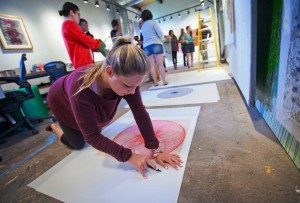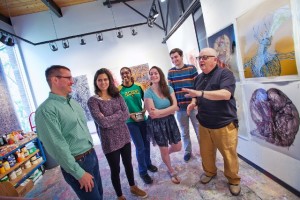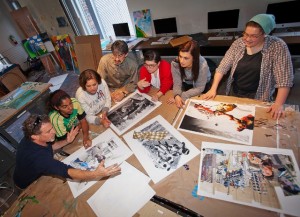Ben Williamson ’16 was searching for something big, a project that would allow him to explore his passion for graphic design and digital photography. Ed Kerns, Eugene H. Clapp II ’36 Professor of Art, had the answer: Frankenstein 2029.

Madison Murray ’16 prepares a piece for framing.
Co-produced by Kerns and Suzanne Westfall, professor of English/theater and interim director of the arts, Frankenstein 2029 involves over 50 faculty members and students from art, chemistry, computer science, engineering, English, neuroscience, and theater. The project is part of the College’s START initiative to integrate the arts throughout the curriculum, which is funded by an $800,000 grant from the Mellon Foundation.
“This is a big moment for Lafayette,” says Kerns. “Frankenstein 2029 goes well beyond the standard definition of collaboration in which, typically, a couple people from different disciplines get together and ask questions that the other can answer. For this, disciplines are getting together and asking questions neither can answer alone. This project will demonstrate what makes Lafayette really interesting and that is an overall intellectual unity.”
Williamson, a double major in art and film & media studies from Hingham, Mass., will create promotional materials for the performance art piece like posters, brochures, trailers, previews, and photographs.

James Ferri, left, James T. Marcus Professor and head of chemical and biomolecular engineering, and Ed Kerns, right, Eugene H. Clapp II ’36 Professor of Art, discuss the project with students.
Luis Schettino, assistant professor of psychology and neuroscience, will assist with scientific background and hopes to provide some audiovisual elements as special effects.
Based on Mary Shelley’s gothic novel Frankenstein, published in the 19th century, the project wrestles with universal issues that still resonate with modern audiences, including hubris, identity, parenting, science and technology, and the nature of life.
Frankenstein 2029 will be a simultaneous, four-venue production. The venues include a 21st century version of Mary Shelley’s libertine apartment, Victor Frankenstein’s lab, the ship where Victor recounts his tale to Captain Walton after being rescued during his pursuit of the creature, and the playground where the creature murders Victor’s youngest brother, William, after learning he has no soul.
Neural maps will help audience members navigate between stages, and “helpers” will guide them between venues and maintain the ethereal ambiance (there will be little or no dialogue). Because spectators will choose how they view the production, each person will experience a different performance. They may follow a particular character (actors will move among venues) or explore the venue itself, which will remain “alive” after the actors have left.

Jim Toia, left, director of the College’s Community Arts Program, discusses design concepts with members of the team.
For example, theater and history double major Samantha Meyerson ’15 (Easton, Pa.) is working on staging the desk in Victor’s lab with letters, failed experiments, notes, and drawings. She and Kerns want the lab to be as detailed as possible so the audience can gain a better sense of who Victor is by looking through his papers. She also will portray a lab assistant.
Madison Murray ’16 (Palos Verdes Estates, Calif.), a double major in art and Spanish, is helping to create and print digital images that will be set up around the stage, and later, she will direct one of the venues.
Set to debut next spring, Frankenstein 2029 will feature an original score by Tom DiGiovanni ’96 and original movement by Ben Munisteri, choreographer-in-residence.


